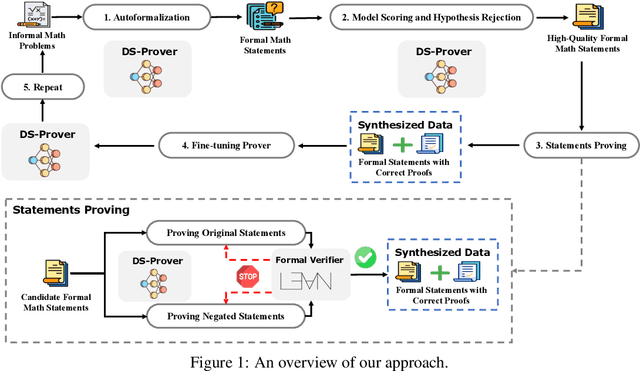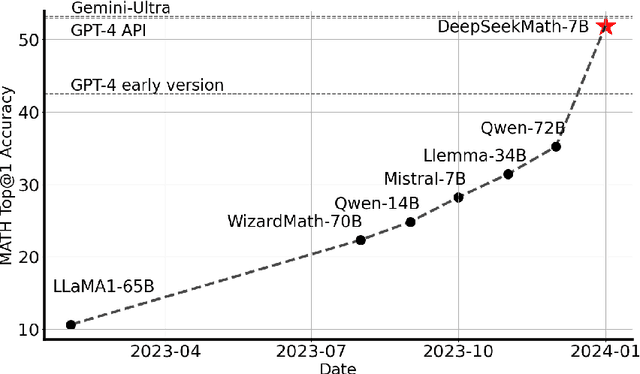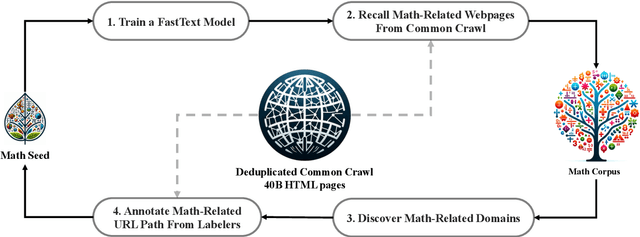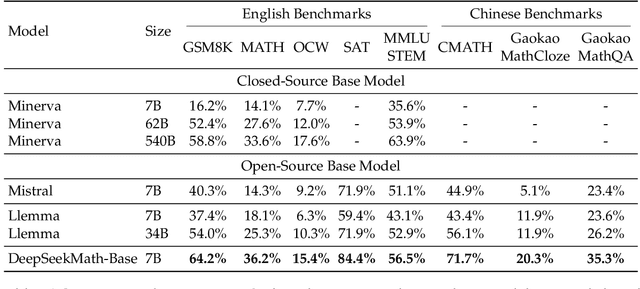Qihao Zhu
DeepSeek-V3 Technical Report
Dec 27, 2024



Abstract:We present DeepSeek-V3, a strong Mixture-of-Experts (MoE) language model with 671B total parameters with 37B activated for each token. To achieve efficient inference and cost-effective training, DeepSeek-V3 adopts Multi-head Latent Attention (MLA) and DeepSeekMoE architectures, which were thoroughly validated in DeepSeek-V2. Furthermore, DeepSeek-V3 pioneers an auxiliary-loss-free strategy for load balancing and sets a multi-token prediction training objective for stronger performance. We pre-train DeepSeek-V3 on 14.8 trillion diverse and high-quality tokens, followed by Supervised Fine-Tuning and Reinforcement Learning stages to fully harness its capabilities. Comprehensive evaluations reveal that DeepSeek-V3 outperforms other open-source models and achieves performance comparable to leading closed-source models. Despite its excellent performance, DeepSeek-V3 requires only 2.788M H800 GPU hours for its full training. In addition, its training process is remarkably stable. Throughout the entire training process, we did not experience any irrecoverable loss spikes or perform any rollbacks. The model checkpoints are available at https://github.com/deepseek-ai/DeepSeek-V3.
DeepSeek-Prover-V1.5: Harnessing Proof Assistant Feedback for Reinforcement Learning and Monte-Carlo Tree Search
Aug 15, 2024



Abstract:We introduce DeepSeek-Prover-V1.5, an open-source language model designed for theorem proving in Lean 4, which enhances DeepSeek-Prover-V1 by optimizing both training and inference processes. Pre-trained on DeepSeekMath-Base with specialization in formal mathematical languages, the model undergoes supervised fine-tuning using an enhanced formal theorem proving dataset derived from DeepSeek-Prover-V1. Further refinement is achieved through reinforcement learning from proof assistant feedback (RLPAF). Beyond the single-pass whole-proof generation approach of DeepSeek-Prover-V1, we propose RMaxTS, a variant of Monte-Carlo tree search that employs an intrinsic-reward-driven exploration strategy to generate diverse proof paths. DeepSeek-Prover-V1.5 demonstrates significant improvements over DeepSeek-Prover-V1, achieving new state-of-the-art results on the test set of the high school level miniF2F benchmark ($63.5\%$) and the undergraduate level ProofNet benchmark ($25.3\%$).
DeepSeek-Coder-V2: Breaking the Barrier of Closed-Source Models in Code Intelligence
Jun 17, 2024



Abstract:We present DeepSeek-Coder-V2, an open-source Mixture-of-Experts (MoE) code language model that achieves performance comparable to GPT4-Turbo in code-specific tasks. Specifically, DeepSeek-Coder-V2 is further pre-trained from an intermediate checkpoint of DeepSeek-V2 with additional 6 trillion tokens. Through this continued pre-training, DeepSeek-Coder-V2 substantially enhances the coding and mathematical reasoning capabilities of DeepSeek-V2, while maintaining comparable performance in general language tasks. Compared to DeepSeek-Coder-33B, DeepSeek-Coder-V2 demonstrates significant advancements in various aspects of code-related tasks, as well as reasoning and general capabilities. Additionally, DeepSeek-Coder-V2 expands its support for programming languages from 86 to 338, while extending the context length from 16K to 128K. In standard benchmark evaluations, DeepSeek-Coder-V2 achieves superior performance compared to closed-source models such as GPT4-Turbo, Claude 3 Opus, and Gemini 1.5 Pro in coding and math benchmarks.
DeepSeek-Prover: Advancing Theorem Proving in LLMs through Large-Scale Synthetic Data
May 23, 2024



Abstract:Proof assistants like Lean have revolutionized mathematical proof verification, ensuring high accuracy and reliability. Although large language models (LLMs) show promise in mathematical reasoning, their advancement in formal theorem proving is hindered by a lack of training data. To address this issue, we introduce an approach to generate extensive Lean 4 proof data derived from high-school and undergraduate-level mathematical competition problems. This approach involves translating natural language problems into formal statements, filtering out low-quality statements, and generating proofs to create synthetic data. After fine-tuning the DeepSeekMath 7B model on this synthetic dataset, which comprises 8 million formal statements with proofs, our model achieved whole-proof generation accuracies of 46.3% with 64 samples and 52% cumulatively on the Lean 4 miniF2F test, surpassing the baseline GPT-4 at 23.0% with 64 samples and a tree search reinforcement learning method at 41.0%. Additionally, our model successfully proved 5 out of 148 problems in the Lean 4 Formalized International Mathematical Olympiad (FIMO) benchmark, while GPT-4 failed to prove any. These results demonstrate the potential of leveraging large-scale synthetic data to enhance theorem-proving capabilities in LLMs. Both the synthetic dataset and the model will be made available to facilitate further research in this promising field.
Reading Users' Minds from What They Say: An Investigation into LLM-based Empathic Mental Inference
Mar 20, 2024Abstract:In human-centered design, developing a comprehensive and in-depth understanding of user experiences, i.e., empathic understanding, is paramount for designing products that truly meet human needs. Nevertheless, accurately comprehending the real underlying mental states of a large human population remains a significant challenge today. This difficulty mainly arises from the trade-off between depth and scale of user experience research: gaining in-depth insights from a small group of users does not easily scale to a larger population, and vice versa. This paper investigates the use of Large Language Models (LLMs) for performing mental inference tasks, specifically inferring users' underlying goals and fundamental psychological needs (FPNs). Baseline and benchmark datasets were collected from human users and designers to develop an empathic accuracy metric for measuring the mental inference performance of LLMs. The empathic accuracy of inferring goals and FPNs of different LLMs with varied zero-shot prompt engineering techniques are experimented against that of human designers. Experimental results suggest that LLMs can infer and understand the underlying goals and FPNs of users with performance comparable to that of human designers, suggesting a promising avenue for enhancing the scalability of empathic design approaches through the integration of advanced artificial intelligence technologies. This work has the potential to significantly augment the toolkit available to designers during human-centered design, enabling the development of both large-scale and in-depth understanding of users' experiences.
DeepSeekMath: Pushing the Limits of Mathematical Reasoning in Open Language Models
Feb 06, 2024



Abstract:Mathematical reasoning poses a significant challenge for language models due to its complex and structured nature. In this paper, we introduce DeepSeekMath 7B, which continues pre-training DeepSeek-Coder-Base-v1.5 7B with 120B math-related tokens sourced from Common Crawl, together with natural language and code data. DeepSeekMath 7B has achieved an impressive score of 51.7% on the competition-level MATH benchmark without relying on external toolkits and voting techniques, approaching the performance level of Gemini-Ultra and GPT-4. Self-consistency over 64 samples from DeepSeekMath 7B achieves 60.9% on MATH. The mathematical reasoning capability of DeepSeekMath is attributed to two key factors: First, we harness the significant potential of publicly available web data through a meticulously engineered data selection pipeline. Second, we introduce Group Relative Policy Optimization (GRPO), a variant of Proximal Policy Optimization (PPO), that enhances mathematical reasoning abilities while concurrently optimizing the memory usage of PPO.
DeepSeek-Coder: When the Large Language Model Meets Programming -- The Rise of Code Intelligence
Jan 26, 2024



Abstract:The rapid development of large language models has revolutionized code intelligence in software development. However, the predominance of closed-source models has restricted extensive research and development. To address this, we introduce the DeepSeek-Coder series, a range of open-source code models with sizes from 1.3B to 33B, trained from scratch on 2 trillion tokens. These models are pre-trained on a high-quality project-level code corpus and employ a fill-in-the-blank task with a 16K window to enhance code generation and infilling. Our extensive evaluations demonstrate that DeepSeek-Coder not only achieves state-of-the-art performance among open-source code models across multiple benchmarks but also surpasses existing closed-source models like Codex and GPT-3.5. Furthermore, DeepSeek-Coder models are under a permissive license that allows for both research and unrestricted commercial use.
DeepSeek LLM: Scaling Open-Source Language Models with Longtermism
Jan 05, 2024



Abstract:The rapid development of open-source large language models (LLMs) has been truly remarkable. However, the scaling law described in previous literature presents varying conclusions, which casts a dark cloud over scaling LLMs. We delve into the study of scaling laws and present our distinctive findings that facilitate scaling of large scale models in two commonly used open-source configurations, 7B and 67B. Guided by the scaling laws, we introduce DeepSeek LLM, a project dedicated to advancing open-source language models with a long-term perspective. To support the pre-training phase, we have developed a dataset that currently consists of 2 trillion tokens and is continuously expanding. We further conduct supervised fine-tuning (SFT) and Direct Preference Optimization (DPO) on DeepSeek LLM Base models, resulting in the creation of DeepSeek Chat models. Our evaluation results demonstrate that DeepSeek LLM 67B surpasses LLaMA-2 70B on various benchmarks, particularly in the domains of code, mathematics, and reasoning. Furthermore, open-ended evaluations reveal that DeepSeek LLM 67B Chat exhibits superior performance compared to GPT-3.5.
Toward Artificial Empathy for Human-Centered Design: A Framework
Mar 19, 2023Abstract:In the early stages of the design process, designers explore opportunities by discovering unmet needs and developing innovative concepts as potential solutions. From a human-centered design perspective, designers must develop empathy with people to truly understand their needs. However, developing empathy is a complex and subjective process that relies heavily on the designer's empathetic capability. Therefore, the development of empathetic understanding is intuitive, and the discovery of underlying needs is often serendipitous. This paper aims to provide insights from artificial intelligence research to indicate the future direction of AI-driven human-centered design, taking into account the essential role of empathy. Specifically, we conduct an interdisciplinary investigation of research areas such as data-driven user studies, empathetic understanding development, and artificial empathy. Based on this foundation, we discuss the role that artificial empathy can play in human-centered design and propose an artificial empathy framework for human-centered design. Building on the mechanisms behind empathy and insights from empathetic design research, the framework aims to break down the rather complex and subjective concept of empathy into components and modules that can potentially be modeled computationally. Furthermore, we discuss the expected benefits of developing such systems and identify current research gaps to encourage future research efforts.
Biologically Inspired Design Concept Generation Using Generative Pre-Trained Transformers
Dec 26, 2022Abstract:Biological systems in nature have evolved for millions of years to adapt and survive the environment. Many features they developed can be inspirational and beneficial for solving technical problems in modern industries. This leads to a specific form of design-by-analogy called bio-inspired design (BID). Although BID as a design method has been proven beneficial, the gap between biology and engineering continuously hinders designers from effectively applying the method. Therefore, we explore the recent advance of artificial intelligence (AI) for a data-driven approach to bridge the gap. This paper proposes a generative design approach based on the generative pre-trained language model (PLM) to automatically retrieve and map biological analogy and generate BID in the form of natural language. The latest generative pre-trained transformer, namely GPT-3, is used as the base PLM. Three types of design concept generators are identified and fine-tuned from the PLM according to the looseness of the problem space representation. Machine evaluators are also fine-tuned to assess the mapping relevancy between the domains within the generated BID concepts. The approach is evaluated and then employed in a real-world project of designing light-weighted flying cars during its conceptual design phase The results show our approach can generate BID concepts with good performance.
 Add to Chrome
Add to Chrome Add to Firefox
Add to Firefox Add to Edge
Add to Edge